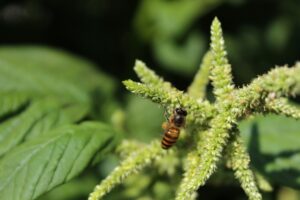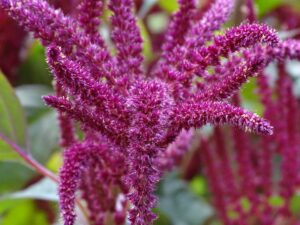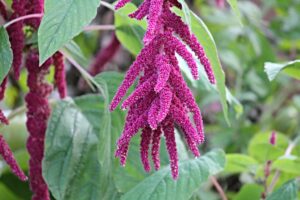When it comes to the amaranth flower, we’re talking about a plant that practically screams, “Look at me!” With their brilliant colors and unique, cascading blooms, amaranth flowers are true garden divas—but don’t worry, they don’t come with diva-level demands. Let’s dive into the world of these gorgeous blooms, covering everything from plant description to growing, caring, propagating, and even finding uses for them in your garden and beyond.
Amaranth Flower: A Colorful Plant Description
The amaranth flower isn’t just beautiful; it’s bold, exotic, and undeniably eye-catching. Known for its feathery, pom-pom, or cascading rope-like blooms, amaranth comes in shades that range from deep reds and magentas to purples and even chartreuse green. Here’s a quick rundown of its visual charms:
- Leaves: Amaranth leaves are typically large and lush, often with tinges of red or green. The foliage alone adds drama to any garden.
- Height: Some varieties of amaranth can reach up to 8 feet tall! But fear not; there are also dwarf varieties perfect for smaller spaces.
- Blooms: The real showstopper is the bloom. Amaranth flowers can be dense and feathery, arranged in long, drooping clusters or upright pom-poms, depending on the variety.
Growing Amaranth Flowers Like a Pro
Amaranth flowers aren’t too fussy, which is excellent news for both beginners and seasoned gardeners. Here’s your guide to getting started.
Sunlight
These beauties love the sun! Plant your amaranth flowers in full sunlight for the best blooms. They’ll grow well in partial shade, but they won’t be as vibrant or robust.
Soil Requirements
Amaranth flowers aren’t picky about soil but do best in well-draining soil rich in organic matter. Amend your soil with compost for added nutrients, and make sure it’s loose enough to allow for good drainage.
Watering
Amaranth is drought-resistant once established, but keep young plants consistently moist. Aim to water about once a week or when the top inch of soil feels dry.
Temperature and Humidity
These plants are warm-weather lovers! Temperatures around 70-80°F are ideal, though they can tolerate slight variations. High humidity isn’t an issue for them, so they’re perfect for warmer climates.
Fertilization
Amaranth flowers aren’t heavy feeders, but a little boost of balanced fertilizer once a month can encourage larger blooms.

Caring for Amaranth Flowers
Once you’ve planted your amaranth, caring for them is as easy as pie (or maybe easier!). Here’s a quick breakdown:
- Mulching: A layer of mulch can help retain moisture and suppress weeds around your amaranth plants.
- Pruning: Amaranth flowers benefit from a little grooming. Pinch back the tips of the plants in the early stages to encourage branching and fuller blooms.
- Pest Patrol: Keep an eye out for aphids and leaf miners. Neem oil or insecticidal soap can help keep pests at bay without harming the plant.
How to Propagate Amaranth Flowers
Propagating amaranth flowers is incredibly straightforward. These plants are generous with their seeds, making them easy to propagate at home. Here’s your step-by-step guide:
Harvest Seeds: Wait for the flowers to mature and dry on the plant. Cut the dried flower heads, place them in a paper bag, and shake to release the seeds.
Sowing: Sow the seeds directly into your garden in spring after the last frost. Simply scatter the seeds, lightly cover them with soil, and water gently.
Thin the Seedlings: When seedlings are a few inches tall, thin them to about 10-12 inches apart to give each plant room to grow.
Uses for Amaranth Flowers: From Ornamental to Edible!
Not only are amaranth flowers fabulous in the garden, but they’re also useful in surprising ways:
- Edible Leaves and Seeds: Both the leaves and seeds of amaranth are edible. Leaves can be cooked like spinach and have a mild, slightly earthy flavor. The seeds, often referred to as ancient grains, are high in protein and make a nutritious addition to porridge, bread, and more.
- Dried Floral Arrangements: Amaranth blooms are stunning even after they’ve dried! Use them in dried flower arrangements to add bold color and texture indoors.
- Attracting Pollinators: Bees and butterflies adore amaranth. Planting amaranth flowers is a great way to attract beneficial pollinators to your garden.
Fun Varieties of Amaranth to Try
If you’re ready to add amaranth flowers to your garden, here are a few delightful varieties to consider:
- Love-Lies-Bleeding – Known for its dramatic, cascading red blooms, this one’s a true show-stealer.
- Hopi Red Dye – The seeds of this amaranth have been used as natural dye, and the deep reddish-purple blooms are captivating.
- Green Tails – A quirky, green-flowered variety with cascading blooms that add a unique twist to any garden.
Final Word: Why Amaranth Flowers Deserve a Spot in Your Garden
Amaranth flowers are the total package: gorgeous, easygoing, and versatile. With just a bit of attention and care, these showy blooms will reward you with lush colors, resilient growth, and even a little snack if you’re feeling adventurous!




